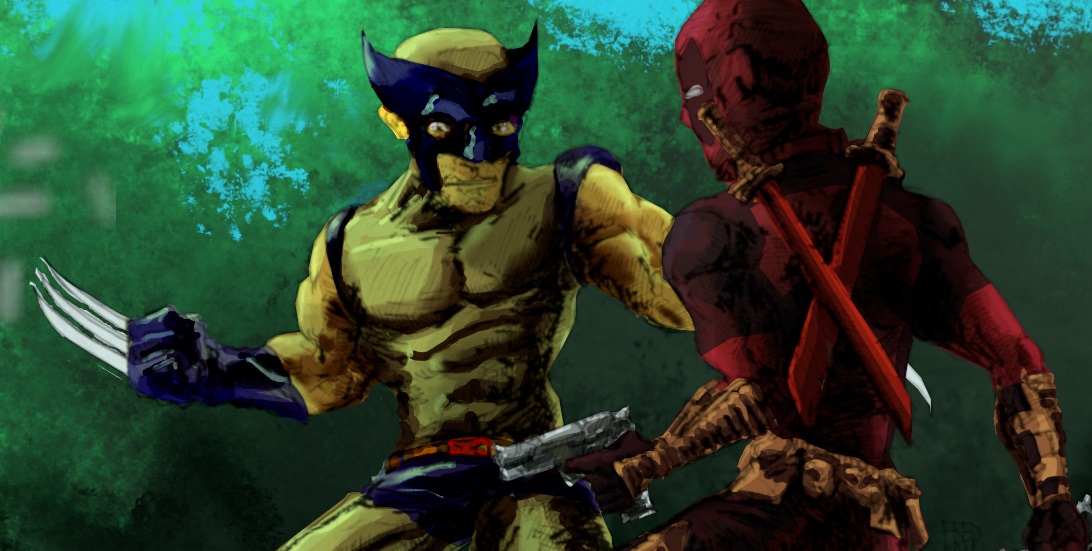Fred and Loathing on The Internet
Welcome to the public web log of Fred Lambuth

Popular Tracks from 2024-07-08
Fancy Cars, Beautiful Women, Large Muscles; A Professional Artist Can Draw Them All!
2024-Jul-08
We’re back on the X-Men beat. The groups suggested for me on social media I find while scrolling through my feeds keep the X-Men coursing around in my day to day thoughts. Mostly the images. Cool as the X-Men are as secret outsiders fighting for truth and justice, they would be nothing if it was not for their visual appeal. DC has plenty of teams of teenagers with angst and drama, but they didn’t leave the mark the X-Men did.
These social media groups nostalgizing about the comic books of my youth are chances for me to inspect the attached images for artist signatures. Guessing who the artists are before finding confirmation is a pleasant enough way to spend time in the indolent haze of browsing on my phone. I copied so much of their work in my youth, I came to learn how to spot their tells.
The first test I make regarding the art is: did Jim Lee make this? Even though I find him to be the outstanding artist for rendering the X-Men, I can easily admit his signature style is limited in range. Jim Lee really only has so many faces and human figures: block-ish and perfectly muscled, respectively. Having two characters within the same image is an easy way to test if Jim Lee is handling the pencils. The whole cast in one panel is a dead giveaway for identifying his work. I do not mean to denigrate the artist for having a somewhat limited range in his recognizable and pleasing style. His pencil lines filling in the shadows with the best crosshatching in the biz. The effort he puts into making real and fictional machinery look real is unparalleled in his time. He had his own style, and it was technically marvelous!
The artistic style for the X-Men could easily be split into pre and post Jim Lee years. The X-Men have now continued on in years to reach the sixth decade of an ongoing mythos. A few artists have made a big dent in the visual expectations for the mutant heroes, villains, and accoutrement used to handle the battle between these two sides of Marvel mutants. No artist has come close to having such a clear definable impact to how the X-Men were developed. (Yeah, I guess John Byrne might be the other…)
I find Jim Lee to be head and shoulders above the rest of any artist to handle main duties on The Uncanny X-Men before him, and rarely surpassed by artists that came after him. His landmark run in the early 90s as the creative force for the visuals of the X-Men comics, is how I think of the X-Men in the 22-page issues, ½ sized newsprint filled with panels of taking figures format. In my mind the X-Men is the production of Chris Claremont and Jim Lee.
His improvement in visual storytelling compared to his peers is overwhelming. Lee was among the first in Marvel to break up the action of the panels into unprecedented visual flourishes. I can only speak anecdotal, but I remember the issues with Jim Lee as the artist being the ones I enjoyed how the speech bubble heavy pages were presented. When I was a young kid, I wanted twenty pages of fights for each issue. The slowed down melodramatic writing Claremont used inhibited that, and for good reason. He also loaded the page down with a lot speech bubles. When parceled out into even sized panels, this can look like a wall of text. Jim Lee would rarely rely on the said grid pattern of panels. Instead conversations would move around the page. Close-ups, frame breakdowns, distant wide shots. All in one page, with free figures sometimes floating between panel lines.
His figures, though cast from a narrow repertoire of only a few dozen face & body combinations, were always expertly rendered. Often comfortably using daring perspectives on each action page. Looking at a collection of late 1980s X-Men issues makes the non-Jim Lee issues look so antiquated side by side.
John Byrne is just not my style. Had I only had his visual delivery of the X-Men to choose over the Kirby’esque look of the pre-Giant Size X-Men era, pre-1975, I’d go with John Byrne. Once I’ve got a taste of the ultra dynamic and sometimes too much of everything style of the 90s that Jim Lee ushered in, I cannot stay content with Byrne’s clean simplicity. The jump from Kirby era X-Men >> Byrne era X-Men is a modest leap compared to the jump between pre and post Jim Lee.
Another artist’s career path I feel proves the influence of Jim Lee on the creative direction of the X-Men and the eventual cementing of visual choices for the franchise is Marc Silvestri.
I knew Silvestri first as a name as one of the few ultra-hot Marvel comic book creators that cleaved off to participate in the creator-owned and super flashy Image Comics. Image Comics was made of a handful of former Marvel artists that felt they could deliver to the comic book audience what they wanted, as artists and often as writers, with new creations even more than they had proven to do so as artists for existing Marvel characters. Silvestri made ‘Cyber Force’. As a kid, I remember finding it one of the least exciting of the first Image titles. (Then again, all of them were a distant 2nd to Todd McFarlane’s Spawn when I was that age.) Nothing about it separated it from the other ‘extreme’ groups of super heroes from the other creators.
For years these creators were right about knowing what the audience wanted. Image sold a lot of comics in the beginning years of the company. For a few years, the top 100 comic books sold each month were swamped Image titles. This was a very short sighted boom in comic books that should be addressed on its own blog post. A lot of ‘Bone Blood Blade Force’ #1 or some such ‘Xtreme’ nonsense could sell quite a bit.
At the time (mid 90s) I could not find too much substantive difference with Marc Silvestri and most of the Jim Lee imitators that filled the Image penciling roles. All the other artists that made up the origin cast of Image Comics had more of a telltale style about them. McFarlane, Liefeld, Portacio. Their work was flawed, amateurish, but exquisite in detail. Brimming with detail. Sometimes the details didn’t make sense!
Often the dazzle of intricately designed colorful figures on the new glossy paper that could handle digitally blended paint was enough to overcome the absurdity of how the artist thought to put a scene together. In this era, a lot of feet were ignored and a lot of curious proportions were made. They were cast in between breathtaking splash pages of square jawed muscly men(and sexy women shaped like snakes with boobs), so the textbook illustration faux pas such as broken perspective were often forgiven by the fans.
Silvestri, in the Outbacker era of the 80s, had the X-Men sharply yet simply illustrated within the very low color count that the cheap pulp paper would allow for. The X-Men could often look like a pulp adventure story like Tarzan or John Carter. Definitely when Rogue and Wolverine spend a half dozen issues without their bright uniform tights.
Until Jim Lee appears on the scene near the end of the 80s, Silvestri was thes standout X-Men artist. The one who made his peers look old-fashioned in their visual choices. The one who made Wolverine look dangerous. Silvestri was better matched to Chris Claremont’s more provocative ideas, compared to the rest of the penciller bullpen at the time. I love the Buscemas, but they’re old fashioned when compared to Lee the Great. They were wonderful for their time. Still a footnote compared to the messianic shift of JL made in year 0 of JL A.D., with the publication of X-Men #1 in 1991.
Jim Lee upped the ante of what is expected of the X-Men. Silvestri, who already made a name for himself as THE X-Men penciller, upped his game to match Lee. Silvestri began to cram more surface detail into his figures, who also started to follow the square-jawed and apex muscle form rules Jim Lee implicitly follows. The change in his Colossus is a plain example of Silvestri adopting a less clean illustration style and taking up the cartoonish proportion of Jim Lee’s Colossus.
CyberForce, the creator made title Silvestri published in Image had the beefed up detail that almost made his work indistinguishable from Jim Lee doing his own thing on W.I.L.D.Cats for Image. Had I not looked into the Outback era of X-Men in the collected volumes from the library, I would never have guessed he started working professionally on the X-Men before Jim Lee. He got caught up in the change that other less experienced artists brought.
After the Marvel superstar left to form Image Comics, the remaining artists in the X-Men bullpen continued the Jim Lee era of slightly over-detailed characters performing some panel breaking action every few pages. Usually with Wolverine taking center stage,
The Kubert brothers took the crown as the closest thing to a Jim Lee performance after they got the job, going a bit too far into the comfortable shapes allowed by the style. Years later Adam and Andy Kubert would find their own more authentic style. This Jim Lee era in X-Men only lasted a handful of years before other voices came in. Voices that took influences other than from Western comics themselves.
Joe Madueiria is the definite next name that could be a candidate for ‘era changer’ in X-Men’s visual lexicon. Big as shift as his style brought to the X-Me, not much of his ideas continued on after his work and era. For a while Beast had a more ‘Beauty and The …’ look he pioneered, but it has not become a lasting interpretation. Iceland occasionally has his hair rendered in ice instead of his classic bald look. Rarely have I seen that replicated, or even Iceman used as an X-Men.
When I was a boy I found ‘MAD’s anime type influence to be a betrayal of the over-detailed illustration style laid down by the covenant of Jim Lee, et al. I found the broad, and more exaggerated proportion so face and body to be alien. This new look was enough to convince me that X-Men comic books just were not for me anymore. They were a great ‘young adult’ story about teenage outsiders doing the best they can to fit into a world that hates them.
Around this time I was moving from elementary school into middle. I wanted to be grown up so badly and the X-Men geared towards teenagers was still ‘kid’s stuff’. By the time I got to the post-Onslaght era of X-Men, I was looking to spend my allowance money at the comic book shop for the more ‘adult’ stuff. Frank Miller work for Dark Horse Comics stuff.

jimmy_james_prod
The 90s was the platinum age of comics! What other time in comics would have bikini specials of the X-Men be top sellers!
2024-07-17 16:07:41.615885
brina_bruja
I will never read the X-Men!
2024-07-19 15:28:10.480867
ariggs
Thanks for the 90's comic book artists 101
2024-07-08 19:59:26.699780